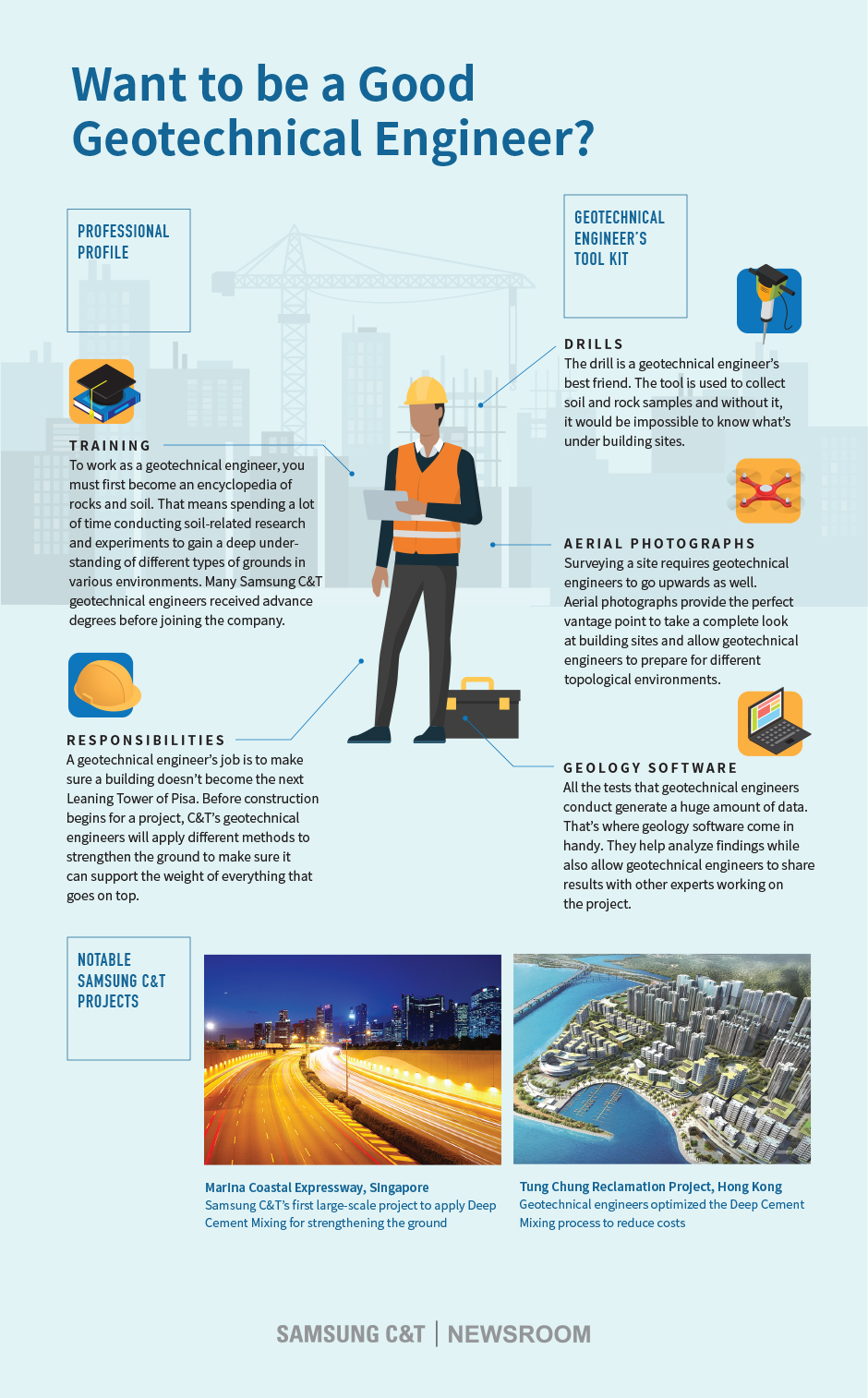Geotheta for Dummies
Geotheta for Dummies
Blog Article
Geotheta Fundamentals Explained
Table of ContentsThe 9-Second Trick For GeothetaNot known Factual Statements About Geotheta The 3-Minute Rule for GeothetaThings about GeothetaSee This Report on Geotheta

They conduct site examinations, accumulate samples, carry out research laboratory examinations, and evaluate data to review the suitability of the ground for construction jobs - Consulting Engineer. Based on their searchings for, geotechnical engineers offer recommendations for foundation design, slope stability, maintaining frameworks, and mitigation of geotechnical hazards. They collaborate with various other professionals, such as engineers, structural designers, and building and construction groups, to make certain that geotechnical factors to consider are integrated into the general project design and implementation
By analyzing the habits and buildings of dirt and rock, they can identify prospective geotechnical threats such as landslides, dirt settlement, or incline instability. Their experience aids avoid failures or accidents that could threaten lives and building. Below are some thorough tasks and responsibilities of a geotechnical designer: Site Investigation: Geotechnical designers conduct website investigations to collect information on subsurface problems.
They translate the data to recognize the residential or commercial properties and behavior of the dirt and rock, including their toughness, leaks in the structure, compaction qualities, and groundwater problems. Geotechnical Evaluation and Design: Geotechnical designers examine the information accumulated during website examinations to analyze the security and viability of the website for construction projects. They execute geotechnical estimations and modeling to examine elements such as birthing capability, negotiation, incline security, side earth stress, and groundwater flow.
The Main Principles Of Geotheta
Structure Style: Geotechnical designers play a vital function in developing foundations that can securely support the designated framework. They assess the soil problems and lots demands to figure out the appropriate structure type, such as shallow structures (e.g., footings), deep foundations (e.g (https://hub.docker.com/u/geotheta)., stacks), or specialized techniques like dirt renovation. They think about aspects such as negotiation limitations, bearing capability, and soil-structure interaction to develop optimal foundation designs
They review construction strategies, screen website activities, and carry out field inspections to validate that the layout recommendations are adhered to. If unforeseen geotechnical concerns arise, they examine the scenario and offer suggestions for remediation or changes to the layout. Risk Analysis and Mitigation: Geotechnical designers analyze geotechnical risks and dangers connected with the project website, such as landslides, liquefaction, or soil erosion.

Partnership and Interaction: Geotechnical designers function closely with other experts entailed in a job, such as designers, architectural designers, and building and construction teams. Effective communication and cooperation are necessary to incorporate geotechnical considerations into the total project layout and building process. Geotechnical engineers supply technological proficiency, answer queries, and ensure that geotechnical needs are satisfied.
The Single Strategy To Use For Geotheta
Below are some sorts of geotechnical designers: Structure Engineer: Structure engineers specialize in designing and assessing structures for structures. They assess the dirt conditions, load demands, and site qualities to determine the most ideal structure type and layout, such as shallow structures, deep foundations, or specialized techniques like stack foundations.
They examine the variables influencing slope stability, such as soil properties, groundwater problems, and incline geometry, and develop strategies to avoid incline failures and minimize risks. Earthquake Designer: Quake engineers specialize in assessing and developing frameworks to stand up to seismic pressures. They examine the seismic danger of a site, evaluate soil liquefaction potential, and develop seismic layout criteria to make certain the security and strength of frameworks during earthquakes.
They carry out field screening, gather examples, and examine the collected information to characterize the dirt homes, geologic formations, and groundwater problems at a site. Geotechnical Instrumentation Designer: Geotechnical instrumentation designers concentrate on tracking and determining the actions of dirt, rock, and frameworks. They mount and maintain instrumentation systems that check factors such as soil settlement, groundwater degrees, incline review motions, and architectural displacements to assess efficiency and supply very early warnings of potential problems.
Not known Facts About Geotheta
They carry out examinations such as triaxial tests, combination examinations, straight shear tests, and leaks in the structure tests to collect data for geotechnical evaluation and layout. Geosynthetics Engineer: Geosynthetics engineers concentrate on the design and application of geosynthetic materials, such as geotextiles, geogrids, and geomembranes. They utilize these materials to improve dirt security, enhance slopes, provide drainage options, and control erosion.
They often tend to be investigatory individuals, which implies they're intellectual, reflective, and investigative. They are interested, methodical, logical, logical, and rational. Some of them are additionally social, suggesting they're kind, generous, participating, client, caring, useful, compassionate, sensible, and friendly - Engineer of Record.
In the workplace environment, geotechnical designers use specialized software tools to execute estimations, develop styles, and evaluate information. They prepare records, testimonial task requirements, interact with customers and group participants, and coordinate project tasks. The office setting offers a conducive environment for research, analysis, and partnership with other professionals included in the job.
The Ultimate Guide To Geotheta
They regularly visit job sites to carry out site examinations, evaluate geotechnical problems, and collect data for evaluation. These visits involve taking a trip to various locations, often in remote or difficult surfaces. Geotechnical engineers might execute dirt sampling, conduct examinations, and monitor construction activities to make sure that the geotechnical facets of the job are being executed correctly.
Geotechnical designers additionally operate in specialized geotechnical laboratories. In these facilities, they carry out experiments, carry out tests on soil and rock examples, and analyze the engineering buildings of the materials. Geotechnical lab engineers function thoroughly in these settings, taking care of testing equipment, running tools, and taping information. They collaborate with other research laboratory personnel to make certain exact and reliable screening outcomes.
Report this page